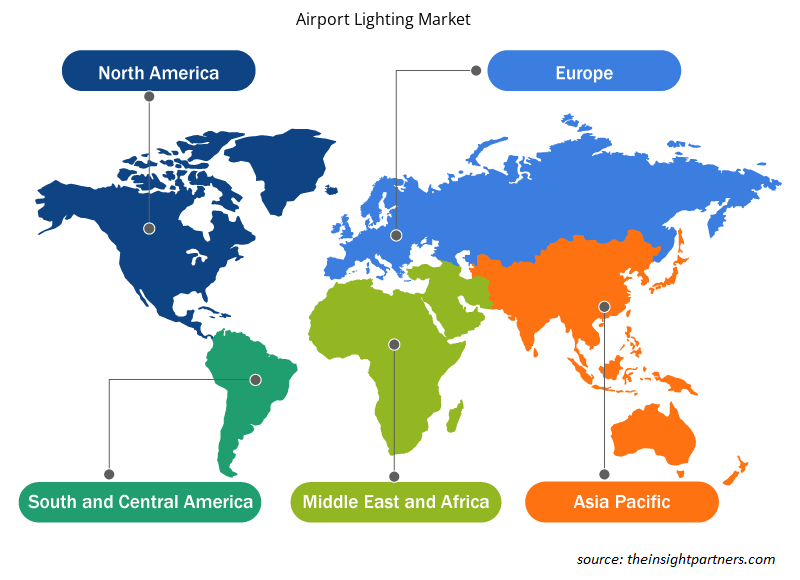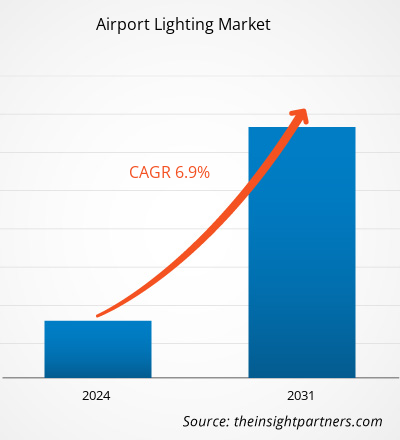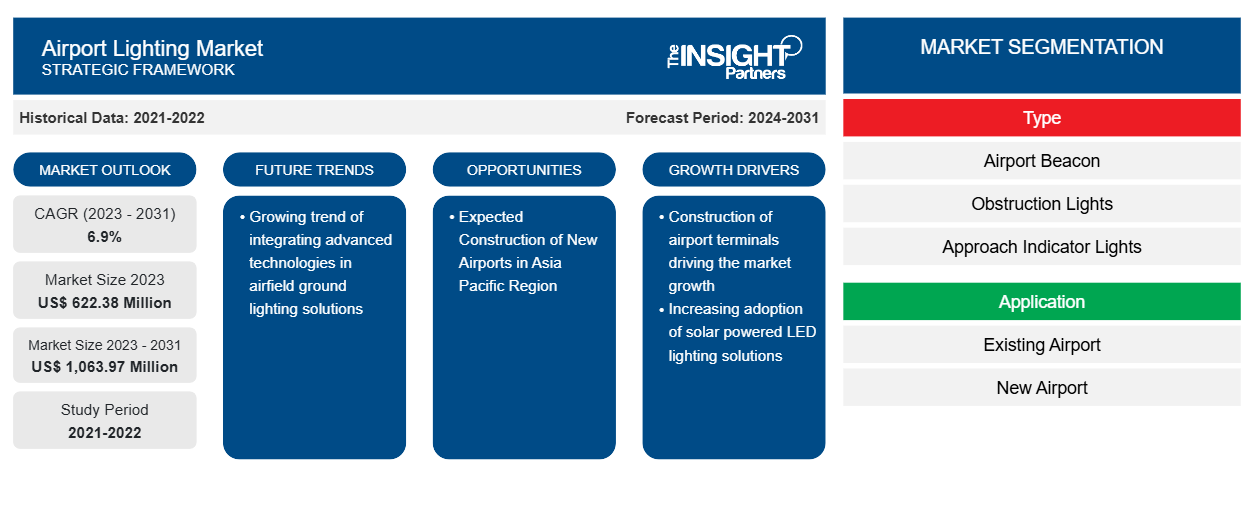Si prevede che la dimensione del mercato dell'illuminazione aeroportuale raggiungerà 1.063,97 milioni di dollari entro il 2031, rispetto ai 622,38 milioni di dollari del 2023. Si prevede che il mercato registrerà un CAGR del 6,9% nel periodo 2023-2031. La crescente tendenza all'integrazione di tecnologie avanzate nelle soluzioni di illuminazione a terra degli aeroporti rimarrà probabilmente una tendenza chiave nel mercato.
Analisi del mercato dell'illuminazione aeroportuale
I produttori di illuminazione aeroportuale si riforniscono di vari componenti da diversi produttori di componenti e li integrano nei loro prodotti. La concorrenza tra i produttori di illuminazione aeroportuale è sempre alta, a causa della crescente domanda di tale tecnologia. Inoltre, le specifiche di queste soluzioni di illuminazione sono definite dalla certificazione, vale a dire FAA e ICAO. Il produttore o fornitore deve competere con i suoi pari in base a prezzo, tempi di consegna e servizi post-vendita, il che di conseguenza aumenta la concorrenza sul mercato. I produttori di prodotti vendono i loro prodotti tramite canali di vendita diretti o tramite distributori offline. Le luci aeroportuali sono anche reperite tramite canali online, il che intensifica ulteriormente la concorrenza tra i giocatori. Alcuni dei principali produttori di illuminazione aeroportuale includono; ADB Safegate, Astronics Corporation, Carmanah Technologies, Honeywell International Inc., OSRAM GmbH e OCEM Airfield Technology, tra gli altri. Il mercato dell'illuminazione aeroportuale è frammentato e diversi giocatori operano nel mercato, contribuendo così a ricavi sostanziali anno dopo anno.
Panoramica del mercato dell'illuminazione aeroportuale
L'analisi della supply chain sul mercato dell'illuminazione aeroportuale analizza il contributo dei player che operano nell'ecosistema, come produttori di materie prime o componenti, OEM, integratori di sistema, canali di vendita e utenti finali. Le luci aeroportuali comprendono diversi componenti, tra cui chip LED , cavi, cordset, portalampade, adattatori per portalampade, sospensioni per lampade e componenti metallici, tra gli altri. I produttori di componenti lavorano in sincronia con i produttori di apparecchiature originali che forniscono ulteriormente i loro prodotti direttamente all'utente finale tramite più canali di vendita o li forniscono all'integratore di sistema che progetta il sistema richiesto e poi lo integra in aeroporto. Per soddisfare le esigenze in rapida evoluzione delle soluzioni di illuminazione aeroportuale, questi produttori di componenti investono ingenti somme nella progettazione e nello sviluppo di ingranaggi robusti. A causa dell'importanza di ciascun componente, gli utenti finali e le autorità di certificazione stanno enfatizzando molto la specifica delle misurazioni. Alcuni dei produttori di componenti di illuminazione aeroportuale in tutto il mondo includono Cree Inc., AVS Lighting Components e Inlico, tra gli altri. Anche vari altri produttori di componenti operano sul mercato e stanno facilitando i produttori di illuminazione aeroportuale a soddisfare la crescente necessità di tali soluzioni di illuminazione per la rispettiva clientela.
Personalizza questo report in base alle tue esigenze
Riceverai la personalizzazione gratuita di qualsiasi report, comprese parti di questo report, o analisi a livello nazionale, pacchetto dati Excel, oltre a usufruire di grandi offerte e sconti per start-up e università
- Scopri le principali tendenze di mercato in questo rapporto.Questo campione GRATUITO includerà analisi di dati che spaziano dalle tendenze di mercato alle stime e alle previsioni.
Driver e opportunità del mercato dell'illuminazione aeroportuale
La costruzione dei terminal aeroportuali guida la crescita del mercato
Diversi progetti di costruzione di terminal aeroportuali sono stati completati e annunciati nel 2023, il che ha guidato il mercato per l'installazione di illuminazione aeroportuale. Inoltre, i prossimi piani per la costruzione di nuovi terminal aeroportuali probabilmente guideranno il mercato nei prossimi anni. Ad esempio:
- Nel gennaio 2023, l'aeroporto internazionale di Newark Liberty (EWR) ha avviato le operazioni passeggeri nel suo nuovo Terminal A.
- Nel febbraio 2023, l'aeroporto internazionale di Kansas City (USA) ha annunciato l'apertura del suo nuovo terminal unico, che ha sostituito i tre terminal precedentemente operativi.
- Nel marzo 2023, l'aeroporto di Auckland (NZL) ha annunciato un investimento di 3,9 miliardi di dollari nel suo programma di integrazione dei terminal.
- Nell'aprile 2023, l'aeroporto internazionale di Chennai (IND) ha annunciato l'apertura del suo nuovo terminal che si estende su 136.295 metri quadrati e ha aumentato la capacità dell'aeroporto da 23 a 30 milioni di passeggeri all'anno.
Tali fattori hanno fatto aumentare la domanda di illuminazione aeroportuale per le applicazioni nei terminal.
Costruzione prevista di nuovi aeroporti nella regione Asia-Pacifico
L'aumento dei nuovi progetti di costruzione è uno dei principali fattori che probabilmente offrirà nuove opportunità per i venditori di mercato nei prossimi anni. Ad esempio, nel 2018, la Civil Aviation Administration of China (CAAC) ha annunciato la costruzione di 216 nuovi aeroporti nel paese entro la fine del 2035. Allo stesso modo, anche il governo indiano ha annunciato investimenti per un valore di 12 miliardi di dollari USA per la costruzione di 72 nuovi aeroporti entro la fine del 2025. È probabile che tali fattori generino una nuova domanda di soluzioni di illuminazione aeroportuale in tutta la regione Asia-Pacifico e offriranno nuove opportunità per i venditori di mercato nei prossimi anni.
Analisi della segmentazione del rapporto di mercato dell'illuminazione aeroportuale
I segmenti chiave che hanno contribuito alla derivazione dell'analisi del mercato dell'illuminazione aeroportuale sono tipologia e applicazione.
- In base al tipo, il mercato dell'illuminazione aeroportuale è segmentato in fari aeroportuali , luci di ostacolo, luci di avvicinamento, luci di mezzeria pista, luci di rullaggio e altri. Il segmento delle luci di avvicinamento ha detenuto una quota di mercato maggiore nel 2023.
- In base all'applicazione, il mercato dell'illuminazione aeroportuale è segmentato in aeroporti esistenti e nuovi aeroporti. Il segmento degli aeroporti esistenti ha detenuto una quota di mercato maggiore nel 2023.
Analisi della quota di mercato dell'illuminazione aeroportuale per area geografica
L'ambito geografico del rapporto sul mercato dell'illuminazione aeroportuale è suddiviso principalmente in cinque regioni: Nord America, Europa, Asia Pacifico, Medio Oriente e Africa e Sud America.
L'Asia Pacifica ha dominato il mercato nel 2023, seguita dalle regioni di Europa e Nord America. Inoltre, è probabile che l'Asia Pacifica assista anche al CAGR più elevato nei prossimi anni. Ciò è dovuto principalmente alla presenza di un gran numero di nuovi progetti di costruzione di aeroporti nei paesi della regione APAC nei prossimi anni. Ad esempio, India e Cina hanno già annunciato di voler costruire più di 285 aeroporti entro la fine del 2035, il che dovrebbe ulteriormente stimolare la domanda di soluzioni di illuminazione aeroportuale nella regione.
Approfondimenti regionali sul mercato dell'illuminazione aeroportuale
Le tendenze regionali e i fattori che influenzano il mercato dell'illuminazione aeroportuale durante il periodo di previsione sono stati ampiamente spiegati dagli analisti di Insight Partners. Questa sezione discute anche i segmenti e la geografia del mercato dell'illuminazione aeroportuale in Nord America, Europa, Asia Pacifico, Medio Oriente e Africa e Sud e Centro America.

- Ottieni i dati specifici regionali per il mercato dell'illuminazione aeroportuale
Ambito del rapporto sul mercato dell'illuminazione aeroportuale
| Attributo del report | Dettagli |
|---|---|
| Dimensioni del mercato nel 2023 | 622,38 milioni di dollari USA |
| Dimensioni del mercato entro il 2031 | 1.063,97 milioni di dollari USA |
| CAGR globale (2023-2031) | 6,9% |
| Dati storici | 2021-2022 |
| Periodo di previsione | 2024-2031 |
| Segmenti coperti | Per tipo
|
| Regioni e Paesi coperti | America del Nord
|
| Leader di mercato e profili aziendali chiave |
|
Densità degli attori del mercato: comprendere il suo impatto sulle dinamiche aziendali
Il mercato dell'illuminazione aeroportuale sta crescendo rapidamente, spinto dalla crescente domanda degli utenti finali dovuta a fattori quali l'evoluzione delle preferenze dei consumatori, i progressi tecnologici e una maggiore consapevolezza dei vantaggi del prodotto. Con l'aumento della domanda, le aziende stanno ampliando le loro offerte, innovando per soddisfare le esigenze dei consumatori e capitalizzando sulle tendenze emergenti, il che alimenta ulteriormente la crescita del mercato.
La densità degli operatori di mercato si riferisce alla distribuzione di aziende o società che operano in un particolare mercato o settore. Indica quanti concorrenti (operatori di mercato) sono presenti in un dato spazio di mercato in relazione alle sue dimensioni o al valore di mercato totale.
Le principali aziende che operano nel mercato dell'illuminazione aeroportuale sono:
- Porta sicura ADB
- Illuminazione dell'aeroporto
- Società Astronica
- Sistemi Avlite
- Tecnologie Carmanah
Disclaimer : le aziende elencate sopra non sono classificate secondo un ordine particolare.

- Ottieni una panoramica dei principali attori del mercato dell'illuminazione aeroportuale
Notizie e sviluppi recenti sul mercato dell'illuminazione aeroportuale
Il mercato dell'illuminazione aeroportuale viene valutato raccogliendo dati qualitativi e quantitativi dopo la ricerca primaria e secondaria, che include importanti pubblicazioni aziendali, dati associativi e database. Di seguito sono elencati alcuni degli sviluppi nel mercato dell'illuminazione aeroportuale:
- Honeywell (NASDAQ: HON) ha annunciato oggi il lancio del suo stabilimento di produzione Airfield Ground Lighting (AGL) a Gurugram, in India. AGL è un prodotto Made in India progettato e realizzato completamente in India. AGL svolge un ruolo cruciale nelle operazioni aeroportuali ed è soggetto a normative complete di sicurezza e conformità da parte di enti normativi e standard aeronautici globali. (Fonte: Honeywell International inc, comunicato stampa, agosto 2023)
ADB SAFEGATE è lieta di annunciare il lancio dei suoi nuovi dispositivi AXON EQ, una gamma di luci LED intelligenti da incasso dotate di sensori integrati per raccogliere dati situazionali. Le luci AXON EQ sono dotate di telecomandi LINC 360 integrati, essenziali per creare una comunicazione bidirezionale che consenta operazioni aeroportuali più snelle e predittive. (Fonte: ADB SAFEGATE, comunicato stampa, maggio 2022)
Copertura e risultati del rapporto sul mercato dell'illuminazione aeroportuale
Il rapporto "Dimensioni e previsioni del mercato dell'illuminazione aeroportuale (2021-2031)" fornisce un'analisi dettagliata del mercato che copre le seguenti aree:
- Dimensioni e previsioni del mercato dell'illuminazione aeroportuale a livello globale, regionale e nazionale per tutti i principali segmenti di mercato coperti dall'ambito
- Tendenze del mercato dell'illuminazione aeroportuale e dinamiche di mercato come conducenti, restrizioni e opportunità chiave
- Analisi dettagliata delle cinque forze di Porter
- Analisi del mercato dell'illuminazione aeroportuale che copre le principali tendenze del mercato, il quadro globale e regionale, i principali attori, le normative e i recenti sviluppi del mercato
- Analisi del panorama industriale e della concorrenza che copre la concentrazione del mercato, l'analisi della mappa di calore, i principali attori e gli sviluppi recenti per il mercato dell'illuminazione aeroportuale
- Profili aziendali dettagliati
- Analisi storica (2 anni), anno base, previsione (7 anni) con CAGR
- Analisi PEST e SWOT
- Valore/volume delle dimensioni del mercato - Globale, Regionale, Nazionale
- Industria e panorama competitivo
- Set di dati Excel
Report recenti
Testimonianze
Motivo dell'acquisto
- Processo decisionale informato
- Comprensione delle dinamiche di mercato
- Analisi competitiva
- Analisi dei clienti
- Previsioni di mercato
- Mitigazione del rischio
- Pianificazione strategica
- Giustificazione degli investimenti
- Identificazione dei mercati emergenti
- Miglioramento delle strategie di marketing
- Aumento dell'efficienza operativa
- Allineamento alle tendenze normative























 Ottieni un campione gratuito per - Mercato dell'illuminazione aeroportuale
Ottieni un campione gratuito per - Mercato dell'illuminazione aeroportuale